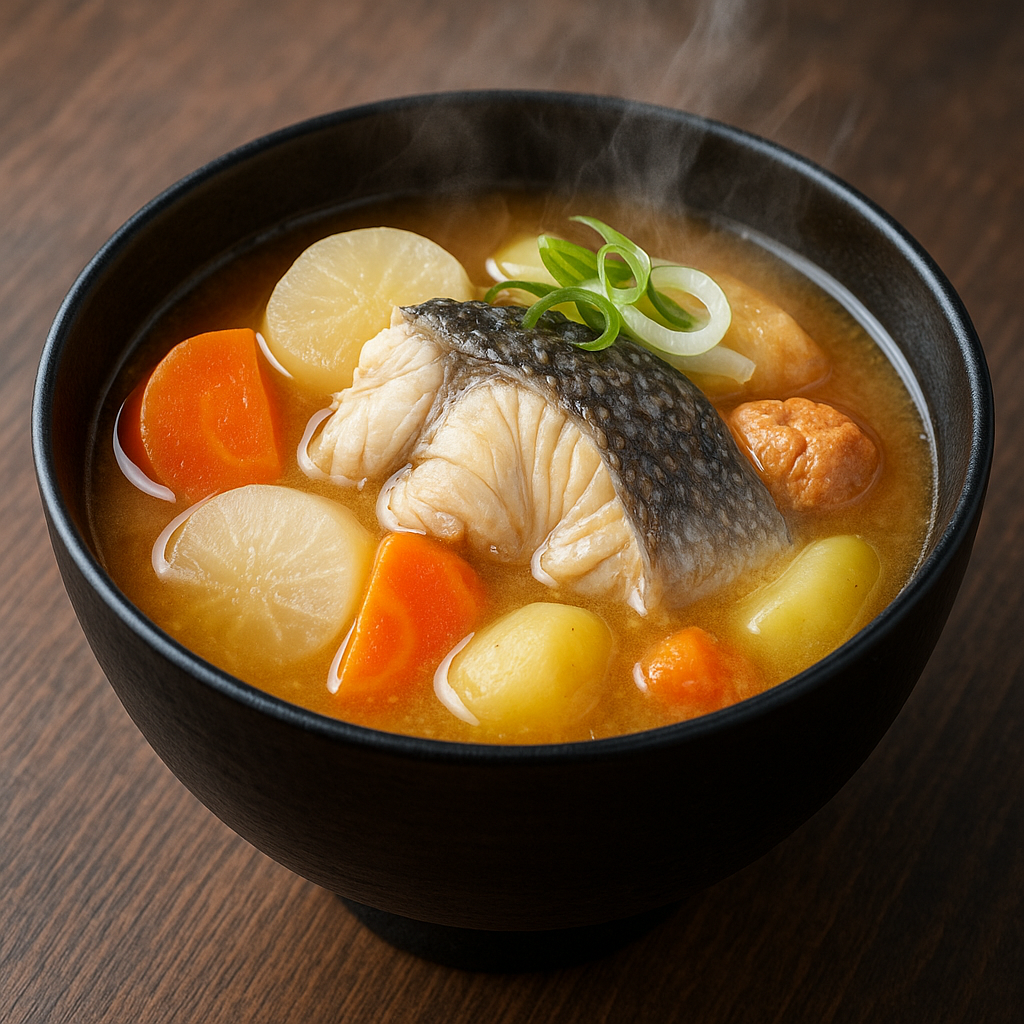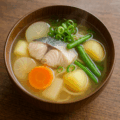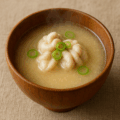かじか汁の特徴
かじかの旨味を活かした鍋料理
かじか汁は、北海道の冬を代表する郷土料理で、まかじか(ゴリやドンコとも呼ばれるハゼ科の魚)を主役にした汁物です。かじかの骨や頭から出る濃厚な出汁が特徴です。
寒い季節にぴったり
冬の漁期に獲れるかじかは脂がのっており、冷えた体を温める汁物として親しまれてきました。
味噌仕立てが主流
昆布やかじかのアラでとった出汁に味噌を溶き、野菜と魚の旨味を合わせるのが一般的です。
かじか汁のレシピ
材料(4人分)
- かじか(下処理済み) … 1尾(約400g)
- 大根 … 1/4本
- 人参 … 1/2本
- 長ネギ … 適量
- 昆布 … 15cm角1枚
- 水 … 1000ml
- 味噌 … 大さじ4〜5
- 酒 … 大さじ2
作り方
- かじかをぶつ切りにし、熱湯で霜降りして臭みを取る。
- 鍋に水と昆布を入れて出汁をとる。
- 野菜を食べやすい大きさに切る。
- 出汁にかじかと酒を入れて煮込み、アクを取りながら煮る。
- 野菜を加えてさらに煮る。
- 味噌を溶き入れ、仕上げに長ネギを散らして完成。
シェフのワンポイントアドバイス
かじかはアラ(骨や頭)を一緒に煮込むと出汁が濃厚になります。
霜降りをする前にかじかに塩をしてから寝かしておくと、旨味がしっかりと際立ちます。
仕上げに柚子皮や七味唐辛子を加えても良いでしょう。
かじか汁の栄養価(1人分の目安)
- エネルギー:約300〜350 kcal
- たんぱく質:20〜25 g
- 脂質:8〜12 g
- 炭水化物:20〜30 g
- カルシウム・リン(魚の骨由来)
- ビタミンD・B群(魚由来)
- 食物繊維(野菜由来)
魚の旨味と野菜の栄養が一度に摂れる、冬の滋養強壮にぴったりの汁物です。
かじか汁の歴史
漁師の鍋料理
かじか汁は、北海道の漁師が冬に獲れたかじかを鍋にして食べたのが始まりとされています。
庶民の味
かつては高級魚ではなく、手に入りやすい魚として家庭で親しまれ、寒い時期の定番料理となりました。
郷土料理としての定着
現在では冬の北海道を代表する郷土料理のひとつとして、観光客にも広く知られています。
English Version
Features of Kajika-jiru
A Hot Pot Highlighting the Flavor of Kajika
Kajika-jiru is a traditional winter dish of Hokkaido, featuring the fish kajika (known as makajika, and sometimes called gori or donko, belonging to the sculpin family). The rich broth comes from simmering the bones and head of the fish.
Perfect for Cold Seasons
Kajika caught during the winter fishing season is rich in fat, making this soup a warming and nourishing dish during the cold months.
Miso-Based Broth
The soup is typically made with dashi from kombu and kajika bones, then seasoned with miso, blending the flavors of vegetables and fish.
Recipe
Ingredients (for 4 servings)
- Kajika (cleaned) … 1 fish (about 400g)
- Daikon radish … 1/4
- Carrot … 1/2
- Green onion … to taste
- Kombu … 1 piece (15 cm square)
- Water … 1000ml
- Miso … 4–5 tbsp
- Sake … 2 tbsp
Instructions
- Cut the kajika into chunks, blanch briefly in hot water to remove odor.
- Place water and kombu in a pot to make stock.
- Cut vegetables into bite-sized pieces.
- Add kajika and sake to the stock, skim off scum, and simmer.
- Add vegetables and continue simmering.
- Stir in miso, garnish with chopped green onion, and serve.
Chef’s Tip
Simmering the bones and head with the fish enriches the broth. Sprinkling salt on the kajika and letting it rest before blanching enhances its umami flavor. Adding yuzu peel or shichimi togarashi at the end gives an extra aroma and kick.
Nutritional Value (per serving, approx.)
- Calories: 300–350 kcal
- Protein: 20–25 g
- Fat: 8–12 g
- Carbohydrates: 20–30 g
- Calcium & phosphorus (from fish bones)
- Vitamin D & B group (from fish)
- Dietary fiber (from vegetables)
A nourishing soup rich in both fish flavor and vegetable nutrients, ideal for winter strength and warmth.
Historical Background
A Fisherman’s Hot Pot
Kajika-jiru is said to have originated with Hokkaido fishermen, who cooked freshly caught kajika in hot pots during the winter season.
A Dish of the Common People
In the past, kajika was not considered a high-class fish, but was easy to obtain, making it a popular household dish and a winter staple.
Established as a Local Specialty
Today, kajika-jiru is recognized as one of Hokkaido’s representative winter dishes and is well-known even among tourists.



何でも質問してください!